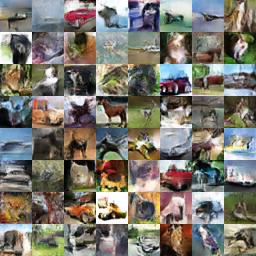Code accompanying our Dist-GAN and GN-GAN (update soon) papers.
Python 2.7 or 3.x, Numpy, scikit-learn, Tensorflow, Keras (1D demo)
For Python 3.x - import pickle in the file distgan_image/modules/dataset.py
We conduct experiments of our model with 1D/2D synthetic data, MNIST, CelebA, CIFAR-10 and STL-10 datasets.
In addition to Dist-GAN, other methods, such as GAN, MDGAN, VAEGAN, WGAN-GP are provided in our 1D code.
>> cd distgan_toy1d
>> python gan_toy1d.py
Quick video demos, you can reproduce easily these videos with our code:
GAN
WGANGP (WGAN-GP can match data distribution at some time, but diverged later)
VAEGAN
Dist-GAN
The visualization part of our 1D code is re-used from here:
>> cd distgan_toy2d
>> python distgan_toy2d.py
We provide three different data layouts you can test on: 'SINE' 'PLUS' 'SQUARE'. Just change the parameter testcase in the code gaan_toy2d.py. For example:
testcase = 'SQUARE'
We provide our code for image datasets, such as: MNIST, CelebA and CIFAR-10.
>> cd distgan_image
>> python distgan_mnist.py
From left to right: Samples generated by our Dist-GAN model (DCGAN for MNIST) and real samples.
Downloading cifar-10 from 'https://www.cs.toronto.edu/~kriz/cifar-10-python.tar.gz' and extracting it into the correct folder: eg. ./data/cifar10/
>> cd distgan_image
>> python distgan_cifar.py
From left to right: Samples generated by our Dist-GAN model (DCGAN) and real samples.
Downloading CelebA from: https://drive.google.com/drive/folders/0B7EVK8r0v71pTUZsaXdaSnZBZzg and extract into the correct folder: eg. ./data/celeba/
>> cd distgan_image
>> python distgan_celeba.py
From left to right: Samples generated by our Dist-GAN model (DCGAN) and real samples.
Downloading STL-10 from: https://ai.stanford.edu/~acoates/stl10/stl10_binary.tar.gz and extract it into a folder. Then, using ./modules/create_stl10.py to read binary file unlabeled_X.bin and save images into a specific folder: eg. ./data/stl-10/
>> cd distgan_image
>> python distgan_stl10.py
From left to right: Samples generated by our Dist-GAN model (with standard CNN architecture [2] + hinge loss) and real samples (right).
FID scores of Dist-GAN for CIFAR-10 and STL-10 datasets are summarized, following experiment setup of [2] with standard CNN architecture (FID is computed with 10K real images and 5K generated images). Dist-GAN is trained with 300K iterations.
| Method | CIFAR-10 | STL-10 |
|---|---|---|
| WGAN-GP [1] | 40.2 | 55.1 |
| SN-GAN [2] | 29.3 | 53.1 |
| SN-GAN (hinge loss) [2] | 25.5 | 43.2 |
| SN-GAN (ResNet) [2] | 21.70 +- .21 | - |
| Dist-GAN | 28.23 | - |
| Dist-GAN (hinge loss) | 22.95 | 36.19 (100K) |
| Dist-GAN (ResNet) | 17.61 +- .30 | 28.50 +- .49 |
If you find this work useful in your research, please consider citing:
@InProceedings{Tran_2018_ECCV,
author = {Tran, Ngoc-Trung and Bui, Tuan-Anh and Cheung, Ngai-Man},
title = {Dist-GAN: An Improved GAN using Distance Constraints},
booktitle = {The European Conference on Computer Vision (ECCV)},
month = {September},
year = {2018}
}
or
@article{tran-2018-abs-1803-08887,
author = {Ngoc{-}Trung Tran and
Tuan{-}Anh Bui and
Ngai{-}Man Cheung},
title = {Dist-GAN: An Improved GAN using Distance Constraints},
journal = {CoRR},
volume = {abs/1803.08887},
year = {2018}
}
- 2018/06/18: Dist-GAN supports standard CNN architecture like SN-GAN [2]. New FID results of standard CNN (+ hinge loss) are added.
- 2018/12/15: Dist-GAN supports ResNet architecture like WGAN-GP [1], SN-GAN [2] (modified from ResNet code of WGAN-GP [1]).
- 2019/04/05: Dist-GAN supports another ResNet architecture (modified from ResNet code of SAGAN [3]).
[1] Ishaan Gulrajani, Faruk Ahmed, Martin Arjovsky, Vincent Dumoulin, Aaron Courville, "Improved Training of Wasserstein GANs", NIPS 2017.
[2] Takeru Miyato, Toshiki Kataoka, Masanori Koyama, Yuichi Yoshida, "Spectral Normalization for Generative Adversarial Networks", ICLR 2018.
[3] Han Zhang, Ian Goodfellow, Dimitris Metaxas, Augustus Odena, "Self-Attention Generative Adversarial Networks", arXiv preprint arXiv:1805.08318 2018.







